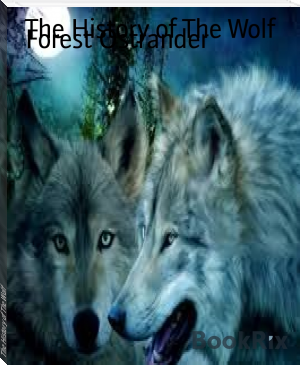Cheeta Facts, Forest Ostrander [little bear else holmelund minarik .txt] 📗

- Author: Forest Ostrander
Book online «Cheeta Facts, Forest Ostrander [little bear else holmelund minarik .txt] 📗». Author Forest Ostrander
The Cheetah is one of the most graceful of the cat family. The cheetah is one of the few members of the cat family which hunts with speed rather than stealth. The cheetah is considered to be the fastest animal on planet Earth.The name cheetah comes from the term 'Chitraka' in the ancient Indian language Sanksrit, which means 'speckled'.
The cheetah is primarily found in Africa. It is said to have evolved in Africa some 7.5 to 26 million years ago and then moved on to Asia.
The cheetah's body is adapted for its speed. It has a slender body with a narrow waist. It has long legs and a deep chest. The cheetah has blunt claws which are semi-retractable.The cheetah weighs from thirty five to fifty kilograms. Its total body length can be anything from one hundred and ten to one hundred and thirty five centimeters.The cheetah has a long tail, with its tail length sometimes reaching till eighty four centimeters.
One of the most important features of the cheetah is it's coat. The cheetah has a coat of small, black spots which is coarse and short. It has a short head and high-set eyes. The cheetah's fur is naturally tailor made to help it camouflage itself while hunting prey. While the upper body of the cheetah is spotted, the cheetah's belly is white is non spotted. The cheetah's black spots measure from two to three centimeters.
Another important aid the cheetah has for hunting are the tear marks along both it's eyes. The tear marks run from its eyes through its cheeks and till its mouth. These tear marks shield the cheetah's eyes from the sun and make it one of the most deadly hunters in the animal kingdom.
The most interesting factor in the cheetah is its speed. The cheetah reaches up to 100 km/hr with short bursts lasting till 450 meters.Also, it has an astounding acceleration of zero to one hundred km/hr in three seconds. This speed is faster than many of the racing cars.
The cheetah has many unique anatomical adaptations which contribute to its speed. It has large nostrils which enable it to optimize its oxygen intake. Also, it has a enlarged heart and lung. The cheetahs heart and lungs work together to circulate oxygen more efficiently as compared to other animals. The cheetah's tail also helps it in its speed. Due to the length of its tail, the cheetah can use it as a rudder to steer,which gives it an added advantage over its prey.
The cheetah cannot roar like other big cats. However, it can purr while inhaling. Though the cheetah cannot growl it can yip, chur, growl, yowl and purr.
The cheetah is vulnerable. It is the least adaptable in the entire cat kingdom. The lifespan of a cheetah is twelve years in the wild and twenty years in captivity. The cheetah mostly eats mammals under fifty kilograms. Some of its oft-hunted prey are the Thomson's Gazelle, Impala, Wildebeests and calves. It also hunts guineafowl and hare.
The cheetah hunts either alone or in groups. It hunts either early in the morning or late in the evening. Cheetahs depend more on their vision rather than scent while hunting. The cheetah chases its prey for about ten to thirty meters. The chase is done with in under a minute. One interesting fact about the cheetah is that it will leave its prey if it doesn't make a quick catch.
The cheetahs have been used in hunting sports in ancient times. Egyptians, Persians and later Indians would engage cheetahs in hunting sports. Cheetahs have also enjoyed being the pets of royalty. Genghis Khan, Charlemagne and in modern times the Emperor of Abysinnia, Haile Selassie had cheetahs as pets.
One of the four super cats to roam this earth, the cheetah (Acinonyx jubatus), though a member of the cat family (Felidae) is uniquely different from the rest of the cats. Cheetahs are known for their phenomenal speed, but lack the climbing abilities present in other cats. This species is the sole surviving member of the genus Acinonyx. It is considered to be the fastest land animal, clocking speeds of up to 120km/h, though it can achieve this in short bursts and over short distances only. This animal can accelerate from 0 to 103km/h (64mph) in three seconds flat, faster than most supercars! Now that's really fast, which brings us to the logical query of what do cheetahs eat so as to maintain such fantastic speeds and an athletic body. Read more on asiatic cheetah.
Cheetah Characteristics and Habitat
The cheetah is different from other cats in the way that it has longer legs and a leaner body. It is also known as the "greyhound" of the cats. Primarily, it is not an aggressive, but rather a shy animal, preferring flight rather than fight. It has weak jaws and rather small teeth for a carnivorous cat, that's the price it has paid for attaining speed. The cheetah can run and catch almost any prey but cannot fight larger predators or protect its kills or young cubs. A common mistake is to consider a cheetah as a leopard, which is certainly not the case. The distinct features of the cheetah are the long tear-drop shaped lines on both sides of the nose running from the corner of the eyes to the mouth. The cheetah has black spots measuring from ¾ to 1 ¼ inches on a tan or buff colored coat. There are spots on the tail which merge to form four to six dark rings but no spots on its white belly. The cheetah is also one of the oldest cats around, having first roamed on this earth an astonishing 18 million years ago!! Phew... now that's what I call really old.
Anyways, the cheetah is found, or rather was found widely in the whole of Africa and south western Asia. Loss of habitat and prey besides hunting has led to rapid decline in the cheetah population and unfortunately it has all but vanished from Asia and most of Africa, rendering it a vulnerable species and could soon end up on the endangered animals list. The cheetah thrives where prey is abundant and where there are vast expanses of land. It prefers to live in an open area of uniform environmental conditions for flora and fauna such as grasslands or semi-desert areas and thick brush wastelands, though it can also be found in diverse habitats such as dense vegetation and hilly terrain. Now having read so much about the cheetah will naturally make you wonder as to what do cheetahs eat and how much. Let's look at their diet and other eating habits in the subsequent paragraph.
What do Cheetahs Eat and Drink
Cheetahs like the other big cats - lions, panthers, jaguars and leopards are carnivores surviving in the wild which means they eat meat, more meat and some more meat. A simple glance at the design of cheetahs' teeth and you will realize that the large canines are for holding and ripping meat from a carcass, razor sharp incisors for snipping slicing and shearing meat. Alright, I agree this all is getting a bit too graphic...The cheetah eats mostly mammals under 40kg (88lb), including deer and antelope like the Thomson's and Grant's gazelle, the springbok and the impala. The young ones of larger mammals such as zebras and wildebeests. When the cats hunt in groups, even adult mammals fall prey. In times of scarcity and hunger warthogs hares and guineafowl are also on their menu. A unique feature about the cheetah is that it is a diurnal hunter which means, unlike other big cats, it hunts early in the morning or later in the evening. As for what do cheetahs drink, well nobody has, as of now, seen them drinking anything besides water. So we can safely say that a cheetah drinks water like all other wild cats.
Cheetahs rely on their vision for hunting rather than scent. The unfortunate prey is stalked to within 10-30m, then hunted down. The whole spectacle, yes it is quite a spectacle though brutal as it may sound, is over in less than a minute. If the cheetah fails to hunt the prey quickly, it will give up. The cheetah has an average success rate of about 30% , seven out of ten chases result in failure. Cheetahs look for animals which have drifted some distance from their pack or group, and do not seek out old or weak ones as is the case with other predators.
Interesting Facts about Cheetahs
•Cheetahs hunt relying more on their excellent vision, rather than their sense of smell.
•Baby cheetahs (called ‘cubs’) fall prey to lions, leopards, hyenas, wild dogs and eagles. Mother cheetahs valiantly try to defend their cubs, but are usually unsuccessful. About 90% of cheetah cubs are killed during the first few weeks of life.
•Cheetahs have a unique purring growl which is let out when they get annoyed or are faced with danger.
•Female cheetahs are known to have a litter of up to 9 cubs at a time, although the normal size of a litter is 3 to 5 cubs.
•Cheetahs are a species under threat and are vulnerable to extinction, loss of natural habitat and other animals, including humans, preying on them are considered to be the main reasons. Read some more cheetah facts.
I hope this article could provide you an insight into what do cheetahs eat, their characteristics and their habitat. The world of the smallest yet most magnificent animal of the feline family is fast shrinking. Come let us try and help this beautiful creation of God by doing our bit, that is to spread awareness.
Cheetah is a member of the cat family. It is known for its speed, hence it is also known as the fastest land animal and can reach speeds of 112 to 120 kilometers per hour. It is also known to accelerate from 0 to 103 kilometers per hour in as short as 3 seconds. Do you realize it is much faster than the most of the fastest cars? With all their speeding abilities, it lacks climbing abilities. The name ‘cheetah’ is derived from a Sanskrit word, which means ‘variegated body’. The name cheetah actually came into use through Hindi. The name given to the cheetah is appropriate, as cheetah in Hindi does mean the spotted one. Since they are known to have high bursts of speed, where do cheetahs live is a natural question, so that they are able to use their speeding abilities.
Cheetah Habitat Information
Previously the cheetahs were more wide spread. One of the cheetah habitat facts, is that they inhabited as far as extreme east India and as north as Southern Kazakhstan. Ancient time fossils of cheetah have also been discovered from China. However with the depleting forest reserve and also with the declining number of these cats, cheetah habitats are indeed dwindling fast.
Today the cheetahs are almost limited to the sub-Saharan Africa. These animals are now mainly found in eastern Africa, around the border between southern Kenya and northern Tanzania. They can also be seen in southern Africa, primarily in northern Namibia, Botswana and western Zambia. It is not that these cats are found in Africa. The largest population of cheetahs, estimated to be at 3000 is said to be in southern and eastern Africa in Namibia. Although in very small numbers, these cats can also be found in northeastern Iran and Northwest Afghanistan. Along with Iran and Afghanistan, they can also be found in northern India. The





Comments (0)